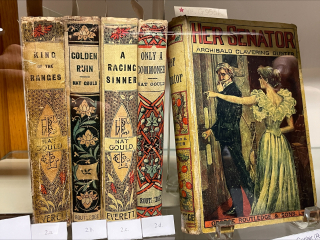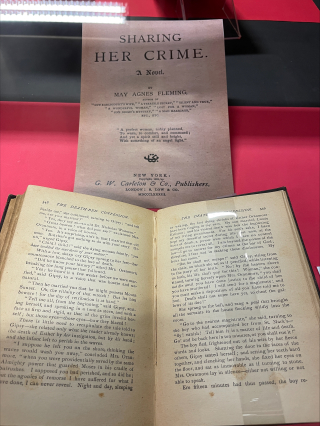From December 1 to 22, the Rare Books and Special Collections at the McLennan Library will be exhibiting “Detecting an Anxious Gaze: The Victorian World in Flux”, a museum display that was curated by graduate students in ENGL 733, Professor Nathalie Cooke’s course on the Victorian Novel.
Cooke’s course surveyed the increase of newspaper and periodical circulation during the Victorian period and the ways in which popular fiction writers leveraged the content and form of newspapers to engage their readers, particularly through the developing genre of detective fiction.

Much like our own contemporary curiosity with true crime, Victorian newspaper readers were bolstered by an appetite for the themes and narratives of crime, mystery and detection. The collaborative project between the Rare Books and Special Collections team and Professor Cooke’s course introduced students to the key elements of museum display and gave them the opportunity to prepare materials that illustrated this Victorian “appetite” for narratives of crime.
The Art of Curating
The exhibit, which features a number of materials from the McLennan Library archives, depicts the various ways in which a society’s growing interest and concern with crime and public safety infiltrated its way into popular fiction and illustrations and texts featured in periodicals and daily newspapers.
“The staff at ROAAr were instrumental in guiding us through displaying text-heavy items in a visually engaging manner,” says PhD student Katelyn Jones. “Additionally, the curatorial process showed the importance of physically interacting with these objects whose form, colours, illustrations, or types all impacted the reading experience.”

“This collaborative experience contributed to my understanding of how Victorian novels are adapted, how their stories are retold, and what parts of their stories and political contexts and commentaries might strategically be left out or altered in adaptations,” says PhD student Charlotte Esme Frank. “It helped me to practice conveying complex ideas concisely and through visual displays, and I feel that I’ve begun to learn the kinds of collaborative and visual skills that are required for museum curation.”
Developing Career-long Skills
One of the course’s unique components was incorporating archival research and giving graduate students the opportunity to consult a library’s holdings, requesting and handling archival materials and collaborating with on-site staff.
“Preparing the text elements of the exhibition was also a helpful exercise in brevity,” says Katelyn, who is pursuing a PhD in Art History. “Crafting didactics for the exhibition challenged me to communicate complex themes in a clear, concise, and compelling manner, which will come in handy in future applications, exhibitions, and publications.”
The project also provided a unique learning experience for Charlotte. “I had not before had the chance to work together with a graduate class towards the organization of an event and exhibition,” she says. “The skills of working as part of a team in this capacity, as well as of working on writing for the general public, rather than for an academic audience, will stay with me.”
Timely Parallels
One would be amiss to ignore the uncanny parallels between our contemporary world and that of the Victorians. Much like us, the Victorians witnessed scientific and technological advances and new and revolutionary ways to communicate and share information. Additionally, crime and policing increased in the Victorian era which gave rise to popular detective figures such as Arthur Conan Doyle’s Sherlock Holmes. Much like our contemporary fascination with true crime, the Victorian’s avidly read and consumed news and literature that dealt with mystery and detection.

In Cooke’s class, students were introduced to books that represented the emerging narrative frameworks of detective fiction, such as Mary Elizabeth Braddon’s Lady Audley’s Secret, Andrew Forrester’s The Female Detective and Catherine Louisa Pirkis’ The Experience of Loveday Brooke, Lady Detective.
When asked about the parallels they discovered during this curation process, Charlotte spoke about her interest in the ways in which Victoria authors such as Poe and Conan Doyle depicted deduction as an objective science.
“I think that in our contemporary moment we have continued to rely on certain kinds of experts and evidence to prove people’s guilt or innocence, even though such methods are in fact not objectively reliable,” she says.
Katelyn agrees that The Victorians were just as fascinated with the morbid details of crime and murder as we are today.
“While sublime engagement with the horrifying and macabre goes back centuries, it was amplified in the nineteenth century by a growing mass media, (the origins of our 24-hour news cycle) and the increasing anonymity of the industrialized city,” she says. “I believe the desire to know our neighbors and the crimes they may be capable of continues to fuel true crime content today.”
Must-see Elements
The exhibit is on display until Friday, December 22 on the fourth floor of the McLennan Library Building. To whet our readers' appetites, we asked Charlotte and Katelyn to tell us about their favourite item in the exhibit.
Katelyn:
“My favorite item in the exhibition is a cartoon from an 1849 edition of Punch titled, “Useful Sunday Literature for the Masses; Or, Murder Made Familiar.” A wife and children surround a man as he reads aloud the gruesome murder of children by their father whose physiognomic description in the paper matches that of the reader. The illustration speaks directly to the still relevant anxiety created by true crime, satirizing the real fear of violence infiltrating the safety of one’s home.”
Charlotte:
“My favourite item in this exhibit are the illustrations of animal-like faces in the display entitled “Frightening Faces: Paranoia and Physiognomy in Victorian Criminology” curated by Katelyn Jones. I think Jones’ display expertly illustrates the disturbing ways in which people thought they could gain insight into others’ characters’ based off of their appearances.”

